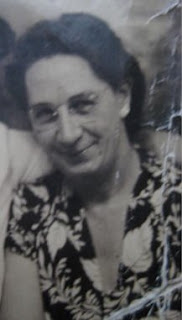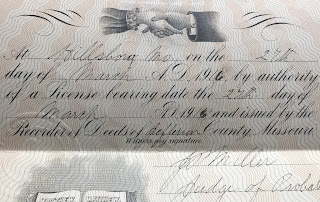Roy and Vivian—
While attending a writing class at church, someone in the class had begun writing her family history with a story of how her grandparents met. As almost the eldest in my family, I thought I’d better write more of my family stories also.
Grandpa Roy grew up in a Baptist farm family of 12 children outside of DeSoto MO near Big River. His mother was the daughter of a German miner and his father was from a Jefferson County Mo. family that had been farming and mining there before statehood. Any schooling Grandpa had would have been in a one room country school.He was raised with hard work and chores, but Roy broke away from the family traditions of farming or mining to work at Missouri Pacific Railroad shop in De Soto, MO as a welder/boilermaker. He was tall with blond good looks and based on notes, postcards, and photos that he saved, he was well loved by the ladies in the area.
Grandma Vivian grew up in a Methodist-Episcopal family with 7 children in a large Victorian home in DeSoto Mo. Her mother’s family was from England and my aunt remembers tea parties and lace-curtain- elegance. Grandma was raised in a more privileged family that was also more fun-loving. During the Depression, an uncle gave all of the girls in the family violins and the boys each got a dime to buy ice cream with. My dad often told stories of riding in the rumble seat of his grandfather’s Packard. Vivian’s father was the foreman of the Missouri Pacific roundhouse and the family travelled often by train to St. Louis for shopping and to Kansas City and Texas where family lived. She was one of those women whose personality and kindness sparkled in her eyes.
I don’t know how they met—the only common thread was Roy worked in the Missouri-Pacific shops and Vivan’s father was the foreman of the Missouri-Pacific roundhouse in the same small town of De Soto, Missouri.. Grandpa had turned many a female head, and Grandma was a small town aristocrat. . . and the boss’s daughter. I have no letters and no photos of them at this time. World War I was looming.
Roy enlisted in the Army Air Corps, not realizing that Vivian was pregnant with dad (LeRoy). LeRoy Harold Long was born Aug. 1918 while Grandpa was in France. While I do have post cards Roy sent his parents, there is no indication that he had become a father. The post cards are letting his parents know that he had landed in New York and would be home soon.
 And Vivian? I have one photo of her at this time, standing in a large circle — she appears to be pregnant. So, she wasn’t sent away or locked in her room. Based on the stories I have heard about her family, I believe she was loved and cherished. Her parents were indulgent with their children, even when they were adults and married. Great grandmother Annie was so beloved that many of her descendants still bear her name (mine is in the middle). They were not stingy with their wealth and freely gave what they had to all of their children that needed it, especially in the Depression where they provided housing for any needing it including one of my aunts (Norma) who lived with them as a teen-ager. So, I believe they did whatever they needed to keep her physically or emotionally healthy.
And Vivian? I have one photo of her at this time, standing in a large circle — she appears to be pregnant. So, she wasn’t sent away or locked in her room. Based on the stories I have heard about her family, I believe she was loved and cherished. Her parents were indulgent with their children, even when they were adults and married. Great grandmother Annie was so beloved that many of her descendants still bear her name (mine is in the middle). They were not stingy with their wealth and freely gave what they had to all of their children that needed it, especially in the Depression where they provided housing for any needing it including one of my aunts (Norma) who lived with them as a teen-ager. So, I believe they did whatever they needed to keep her physically or emotionally healthy.
Roy was discharged from the army on March 27, 1919 and got married on the same day. The witnesses were Mamie and Leo Wilson—Vivian’s sister and brother-in-law. She was 20; he was 25. It's worth noting that Vivian's mother was one of the founding "mothers" of the Episcopal Church in DeSoto. Roy's family were the backbone of their Baptist Church and yet they were married by the Justice of the Peace not in a church. That seemed to be pretty common at that time---at least in my Dad's family. I wish I had one photo of them together when they were young, but starting life together with a 7 month old boy was undoubtedly a big adjustment.
 As far as any of us know, Grandpa, despite his reputation with the ladies, remained faithful in his marriage to Vivian. They had 6 children (Milton died as a baby) and remained married for 32 years until she died in 1951. But, there must have been a little bit of embarrassment on someone’s part since I found their marriage certificate which is in contradiction to the “official marriage records” in Jefferson County, Missouri. The 1919 had been changed to 1916.
As far as any of us know, Grandpa, despite his reputation with the ladies, remained faithful in his marriage to Vivian. They had 6 children (Milton died as a baby) and remained married for 32 years until she died in 1951. But, there must have been a little bit of embarrassment on someone’s part since I found their marriage certificate which is in contradiction to the “official marriage records” in Jefferson County, Missouri. The 1919 had been changed to 1916.


